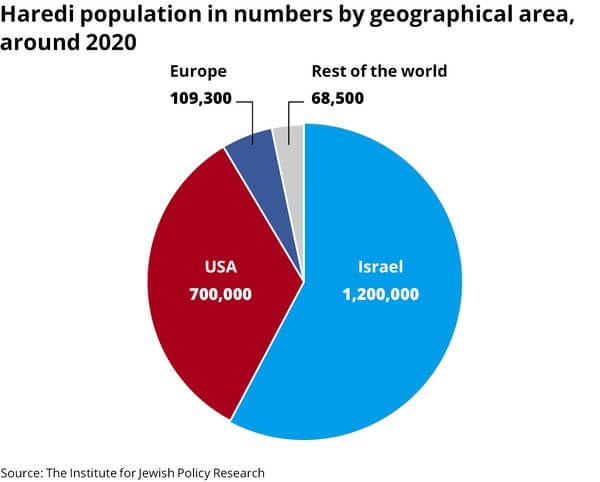Nearly one in four Jews will be ultra-Orthodox by 2040, new study says
A projected boom in the Haredi population worldwide is attributed to other factors besides high fertility rates – including longevity, say researchers from the London-based Institute for Jewish Policy Research.

Haredi men gather in Haifa. Photo by Jack Guez/AFP via Getty Images
This article originally appeared on Haaretz, and was reprinted here with permission. Sign up here to get Haaretz’s free Daily Brief newsletter delivered to your inbox.
One out of every seven Jews in the world today is ultra-Orthodox, or Haredi, according to a first-of-its kind study published Tuesday by the London-based Institute for Jewish Policy Research.
If current trends continue, the study predicted that nearly one out of every four Jews in the world will be Haredi by 2040.
The study estimated the number of ultra-Orthodox Jews in the world today at 2.1 million – 14 percent of the total world Jewish population. This represents the first ever attempt to calculate the global size of this specific community.
The survey found that more than 90 percent of Haredi Jews live in either Israel or the United States – the world’s two largest Jewish population centers. It also found that as much as 80 percent of the growth in the world Jewish population in recent years can be attributed to this community.
High fertility rates among the ultra-Orthodox population is one of the reasons the Haredi population is expected to double over the next 20 years, but it’s not the only one.
The study revealed that Haredi Jews also enjoy considerable longevity. In fact, it found that ultra-Orthodox Jews tend to have a higher-than-average life expectancy, despite the relatively high rates of poverty within the community.
Another factor contributing to the population boom is the high level of “lifestyle retention” in the community: most Jews who are born into the Haredi world stay in the Haredi world. Indeed, according to the survey, the percentage of ultra-Orthodox Jews who leave the fold is so marginal as to have little impact on the overall demographic outlook for the community.

In defining the Haredi population, the study relied on a variety of indicators, including self-identification in previously conducted social surveys, as well as community and school records. Up until quite recently, it noted, there had not been sufficient data available worldwide to compile estimates of its size.
Commenting on the findings, Jewish Policy Research Executive Director Jonathan Boyd said: “The rapid growth of the Haredi population is changing the nature of the Jewish world. It has significant implications for how Jewishness is understood and seen going forward by both Jews and others, and it has to be understood fully to ensure that the needs of the growing Haredi community are met in terms of housing, education and other community services.
“Community leaders need to pay much more attention to these demographic dynamics, and start preparing for what is likely to be a very different future,” he added.
With 35 percent of its Jewish population defined as Haredi, Belgium has the highest concentration of ultra-Orthodox Jews in the world. Given current trends, the survey noted, the percentage of Haredi Jews in the United Kingdom could top that figure in 20 years.
Here are some of the main findings of “Haredi Jews Around the World: Population Trends and Estimates.” The survey was conducted by Dr. Daniel Staetsky, a senior research fellow at Jewish Policy Research and director of its European Jewish Demography Unit.
■ While the world Jewish population has been growing at about 0.7 percent per year over the past decade, the ultra-Orthodox population has been growing by about 3.5 percent to 4 percent annually. At these rates, the Haredi community can be expected to double itself every 18 to 20 years; for the non-Haredi population to do the same, it would take 350 years. Given these trends, Haredi Jews will account for 23 percent of the total world Jewish population by the year 2040.
■ Haredi women have six to seven children, on average. That compares with 1.6 per woman in Europe, 1.8 in the United States and 3 in Israel. “There have been no signs so far that would suggest that Haredi fertility will drop significantly, at least in the short to medium term,” according to the study.
■ The average life expectancy for Haredi men is 83 years and for Haredi women 86 years. That compares with 76 years for American and European men, and 82 years for American and European women on average.
■ Based on data gathered in Israel and the United Kingdom, about 20 percent of all those Jews born into Haredi families are expected to identify as non-Haredi in adulthood. But a significant majority of them – some 60 to 70 percent – will remain observant or traditional even after giving up the Haredi label.
“Religious ‘switching’ among Haredi Jews has been quite well documented and the trend is not powerful enough to change the conclusions regarding Haredi growth over the next 20 years or so,” the study concludes. At most, the study estimates, these “switchers” could push the share of Haredi Jews down from 23 percent to 21 percent of the total by 2040.
■ About 92 percent of all Haredi Jews live in either Israel or the United States. Given that 85 percent of world Jewry live in these two countries, that means the concentration of ultra-Orthodox Jews in Israel and the United States is higher than most other places. According to the study, a total of 1.2 million Haredim live in Israel, where they account for 17 percent of the Jewish population (and 13 percent of the total population), and 700,000 live in the United States, where they account for 12 percent of the Jewish population.
■ Outside of Israel and the United States, the two largest Haredi communities are located in the United Kingdom and Canada. A total of 75,500 Haredim live in the United Kingdom, where they account for 25 percent of the Jewish population. Some 30,000 live in Canada, where they account for 8 percent of the Jewish population.
■ If current trends continue, the study predicted that in 2040, one out of every four Jews in Israel and one out of every five Jews in the United States will be Haredi. “The American Jewish population will resemble today’s European Jewish populations with a very high proportion of Haredim, such as the United Kingdom and Austria,” the study noted. It predicted that by 2040, about 40 percent of British Jews will be ultra-Orthodox. In that case, the United Kingdom could overtake Belgium as the country with the largest concentration of Haredim in the world, according to the study.
This article originally appeared on Haaretz, and was reprinted here with permission. Sign up here to get Haaretz’s free Daily Brief newsletter delivered to your inbox.
















